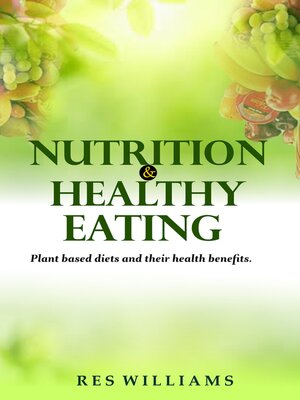
Sign up to save your library
With an OverDrive account, you can save your favorite libraries for at-a-glance information about availability. Find out more about OverDrive accounts.
Find this title in Libby, the library reading app by OverDrive.



Search for a digital library with this title
Title found at these libraries:
| Library Name | Distance |
|---|---|
| Loading... |
Nutrition and healthy eating are essential components of overall well-being, focusing on consuming foods that nourish the body and support optimal health. This involves making informed choices about the types and quantities of food consumed to meet nutritional needs while promoting wellness. Key aspects of nutrition and healthy eating include:
Balanced Diets: Incorporating a variety of foods from different food groups, including fruits, vegetables, whole grains, lean proteins, and healthy fats, to ensure adequate intake of essential nutrients.
Nutrient-Rich Foods: Choosing foods that are rich in vitamins, minerals, fiber, and other beneficial compounds to support bodily functions and prevent nutrient deficiencies.
Mindful Eating: Practicing mindfulness while eating, which involves paying attention to hunger and fullness cues, savoring the flavors and textures of food, and being present during meals to prevent overeating.
Superfoods: Including nutrient-dense foods such as berries, leafy greens, nuts, seeds, and fatty fish that provide a wide range of health benefits due to their high concentrations of vitamins, antioxidants, and phytochemicals.
Hydration: Ensuring adequate fluid intake, primarily through water, to support hydration, digestion, nutrient absorption, and overall cellular function.
Meal Planning: Planning meals and snacks in advance to ensure balanced nutrition, prevent reliance on processed or convenience foods, and support healthy eating habits throughout the week.
Smart Shopping: Making informed choices while grocery shopping by reading food labels, selecting fresh, whole foods over processed options, and prioritizing nutrient-rich ingredients.
Portion Control: Paying attention to portion sizes to avoid overeating and maintain a healthy weight, which is crucial for reducing the risk of chronic diseases such as obesity, diabetes, and heart disease.
Cooking Methods: Using healthy cooking methods such as grilling, baking, steaming, and sautéing instead of frying or deep-frying to minimize added fats and calories while preserving nutritional value.
Dietary Guidelines: Following national dietary guidelines or recommendations tailored to specific health conditions or life stages to ensure comprehensive nutrition and promote overall health and well-being.
Individualized Approach: Recognizing that nutritional needs vary based on factors such as age, gender, activity level, metabolism, and health status, and tailoring dietary choices accordingly to meet individual requirements.
Long-Term Sustainability: Adopting a balanced approach to nutrition that emphasizes long-term sustainability and enjoyment of food, rather than restrictive diets or short-term solutions, to foster a positive relationship with eating and support lifelong health goals.







